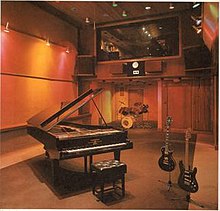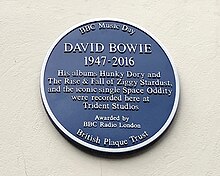Trident Studios
This articleneeds additional citations forverification.(June 2016) |



Trident Studioswas a British recording facility, located at 17St Anne's CourtinLondon'sSohodistrict between 1968 and 1981. It was constructed in 1967 byNorman Sheffield,drummer of the 1960s groupthe Hunters,and his brother Barry.
"My Name is Jack"byManfred Mannwas recorded at Trident in March 1968, and helped launch the studio's reputation. Later that year,the Beatlesrecorded their song "Hey Jude"there and part of theirself-titled double album(also known as the "White Album" ). Other well-known albums and songs recorded at Trident includeElton John's "Your Song",David Bowie'sThe Rise and Fall of Ziggy Stardust and the Spiders from Mars,Lou Reed'sTransformer,Carly Simon'sNo Secrets,andQueen's albumsQueen,Queen IIandSheer Heart Attack.
Other artists recorded at Trident included theBee Gees,Chris de Burgh,Frank Zappa,Genesis,Brand X,James Taylor,Joan Armatrading,Joe Cocker,Golden Earring,Harry Nilsson,Kiss,Tygers of Pan Tang,Lou Reed,Peter Gabriel,Marc Almond,Marc and the Mambas,Smack,Soft Cell,Rick Springfield,the Rolling Stones,Rush,Free,Thin Lizzy,Tina Turner,T.Rex,Van der Graaf Generator,Yes,Black SabbathandJohn Entwistle.
The Sheffield brothers had a relaxed working attitude, but also emphasised high standards ofaudio engineering.[1][page needed]The studio's state-of-the-art recording equipment helped attract many major artists to record there.
The studios are still in operation, now specialising inpost-productionfor TV and Film.
The Beatles and Apple Records
[edit]In mid-1968, Trident Studios was the first in the UK to useDolbynoise reduction,and employ aneight-trackreel-to-reelrecording deck.
WhileAbbey Road Studiosstill used only four-track at the time, Trident'sAmpexeight-track machine drewthe Beatleson 31 July 1968 to record their song "Hey Jude".Paul McCartneylater said about recording the track at Trident: "Words cannot describe the pleasure of listening back to the final mix of 'Hey Jude' on four giant Lockwood / Tannoy speakers which dwarfed everything else in the room..."[1][page needed]The band also recorded some songs for their 1968 double albumThe Beatles(also known as the White Album) at Trident – "Dear Prudence","Honey Pie","Savoy Truffle"and"Martha My Dear"– and on February 22, 1969, they first recorded"I Want You (She's So Heavy)"there for the albumAbbey Road.[2][3]John LennonandYoko Onolater returned with thePlastic Ono Bandto record "Cold Turkey"featuringEric Claptonon lead guitar.
Many of the Beatles'Apple Recordsartists used Trident Studios, includingBadfinger,Billy Preston,Mary Hopkin,Jackie LomaxandJames Taylor.Part ofGeorge Harrison's triple albumAll Things Must Pass,containing the hit "My Sweet Lord",andRingo Starr's "It Don't Come Easy",were also recorded there.Harry Nilssonrecorded "Without You"at Trident, and portions of several of his 1970s albums.
Queen
[edit]The history of the Sheffield brothers and Trident Studios is also linked to the early discovery and success of therockbandQueen.In 1972, Trident Studios started two record production companies, one of which (Neptune Productions) initially signed three artists, Mark Ashton, Eugene Wallace and Queen. The agreements with the artists were for recording and publishing, but Queen had no management, so they insisted that Trident also take on that responsibility. Trident, initially reluctant, eventually agreed and Queen signed an agreement with Trident Recording, Publishing and Management, on 1 November 1972.
The management at the time claimed the deal allowed the band full access to the studio's cutting edge facilities, and supported them by providing the best producers and engineers - so long as the foundations of the band's first albumQueenwere recorded 'off peak'.[4]Roger Taylor later quoted these early off-peak studio hours as "gold dust".[4]
After the album was completed the Sheffield brothers had great difficulty finding a record label to take on the album and release it.[1][page needed]Finally, eight months later, the brothers decided to take on the risk and fund the release themselves and Queen released their self-titled first album under the Trident label in a license deal withEMI Recordsin the UK andElektra Recordsin the US. Trident subsequently releasedQueen IIandSheer Heart Attackunder this same arrangement. After the band left Trident, they signed directly with EMI and Elektra forA Night at the Opera.
David Bowie, Elton John and others
[edit]In March 1968, Manfred Mann recorded Trident's firstnumber oneat the studio, the single "My Name Is Jack".From 1968 to 1981, some of the most reputed artists used the studios for their recordings, includingDavid Bowie,Elton John,Marc Bolan/T.Rex,Carly Simon,Frank Zappa,the Rolling Stones,Free,Genesis,Lou Reed,Joan Armatrading,Black Sabbath,Lindisfarne,Dusty Springfield,theMahavishnu Orchestra,Krisma,Jeff Beck/Rod Stewartand other artists. Elton John's "Your Song"and Carly Simon's"You're So Vain"were both engineered at Trident by Robin Geoffrey Cable, who later went on to produce two albums forthe Dickies.
Tony Stratton-Smith'sCharisma Recordswas also one of the most regular clients of the studios during the 1970s.Genesisrecorded several of their most renowned albums there, includingTrespass(1970),Nursery Cryme(1971) andA Trick of the Tail(1976). The jazz fusion bandBrand Xrecorded their debut studio albumUnorthodox Behaviourhere (1976). Other artists from the label who recorded at Trident wereVan der Graaf Generator,Peter Hammill,LindisfarneandPeter Gabriel.Charisma's first Van der Graaf Generator release,The Least We Can Do Is Wave to Each Other,was recorded at Trident from 11 to 14 December 1969. Most of the album was recorded on eight-track, but the last song, "After the Flood", was recorded on 16. Trident was also among the first studios in the UK to obtain a 16-track machine.[1][page needed]
The Trident 'A' Range console
[edit]
TheTrident A Rangeconsoles were originally designed and built as an in house project by Malcolm Toft who was chief recording engineer at Trident and Barry Porter who was in charge of studio maintenance. Other studios heard about it and placed orders for consoles and Trident Audio Developments was formed with Malcolm Toft as managing director.Cherokee Studiosin Los Angeles was one of the early recipients of one of the first production models, and ultimately purchased three new from Trident and one from a broker at a later time.[1][page needed]David Bowie,Rod Stewart,andFrank Sinatraare among the early artists who first recorded hit records on Cherokee's first 'A' Range console.
"Though it had a very limited run, the Trident A Range console gained a reputation for its very distinct and pleasant sound with a very" musical "EQ section. Along with channel strips from early Neve andHelios consoles,original Trident A Range modules have kept a healthy resale value and are much sought after by engineers who like to combine old-school analogue gear with cutting-edge digital recording technology. "[5]
Studio piano
[edit]Trident also gained a reputation for the sound of its piano, which can be heard on the Beatles' "Hey Jude", Elton John's "Your Song", Carly Simon's "The Right Thing To Do",Queen's"Killer Queen"and many other tracks.[6]It was a handmadeC. Bechsteinconcert-sized instrument that was over one hundred years old.[1][page needed]The piano was offered for auction in November 2001,[7]but failed to sell.[8]
Lockwood Tannoy monitoring speakers
[edit]From 1968 until 1974, Trident used four large monitoring loudspeakers in the control room. These speakers were mentioned by Paul McCartney:
Words cannot describe the pleasure of listening back to the final mix of "Hey Jude" on four giant Lockwood / Tannoy speakers which dwarfed everything else in the room...
— Paul McCartney,[1][page needed]
The recording was done on Lockwood Tannoy speakers, and had to be equalized post-recording to fix the balance of high-end notes.[9] The speaker drivers used were 15-inch dual-concentric Tannoy Golds, which had been newly developed, mounted in cabinets made by Lockwood, UK.[10]They were black in colour and fabricated in Formica with a gold bezel. Two of the original loudspeakers still exist and more information can be found here atThe Original Trident Studios monitoring Loudspeakers - A History[11]
Later history
[edit]Trident Studios was sold in December 1981. It was bought by its senior engineer,Stephen Short,along with three other investors. In 1986, Short bought out the other investors and opened Trident 2 which was opened in 1983 and the investors were J.P. Illiesco andRusty Egan.There were also another group of producers and investors who tried to buy Trident in the 1980s after its initial closure, headed by Neville Kernick-Nixon, Flood and John Keating; the former then opened The Mad House, later known as The Music Station.[12]
The original Trident mixing desk also survived, and was purchased in the early 1980s from the studio's owners by songwriter and formerCurebassistPhil Thornalley.It is now housed in Thornalley's own recording studio, Swamp Studios in north-west London. The Swamp is actually based around the Trident Tri‑mix desk.[13]
Since 1981, the studios have changed name(s) and hands multiple times, with the original building remainingin situ.
Blue plaque
[edit]
On 15 June 2017, a British Plaque Trust permanentblue plaquewas unveiled outside the building at 17 St Anne's Court, London in the recognition of the multiple David Bowie albums recorded there.[14]
Partial discography
[edit]The following is a partial list of work either recorded, mixed or mastered at Trident Studios between 1968 and 1981, edited from the timeline on the Trident Studios official website.[15]A Further list of albums is available atAlbums recorded at Trident Studios
References
[edit]- ^abcdefgSheffield, Norman (2013).Life on Two Legs.Trident Publishing Limited.ISBN978-0957513303.
- ^Ingham, Chris (2006).The Rough Guide to the Beatles.London: Rough Guides. p. 266.ISBN978-1-84353-720-5.
- ^"Abbey Road Anniversary Editions OUT NOW! – the BEATLES".
- ^ab"Queen: From Rags to Rhapsody - BBC Four".BBC.Retrieved9 May2018.
- ^Mix Magazine,1 July 2001
- ^David Bennett (16 March 2020).Rock music's most noteworthy instrument.Archivedfrom the original on 22 December 2021.Retrieved12 June2020.
- ^"Beatles' stage to be auctioned".BBC. 16 November 2001.Retrieved21 June2020.
- ^"Beatle Bummer".NME.28 November 2001.Retrieved21 June2020.
- ^Matteo, Steve (10 August 2004).The Beatles' Let It Be.A&C Black. pp. 13–14.ISBN978-0-8264-1634-6.
- ^Massey, Howard (1 October 2015).The Great British Recording Studios.Hal Leonard Corporation.ISBN978-1-4950-3533-3.
- ^"The Original Trident Studios Monitoring Loudspeakers - A History".www.tannoyista.com.Tannoyista.
- ^"Ping Pong Music".Ping Pong Music. 30 January 2013. Archived fromthe originalon 7 August 2012.Retrieved2 March2013.
- ^"Phil Thornalley".Soundonsound.com.Retrieved2 May2020.
The Swamp is still based around the Trident Tri‑mix desk Thornalley bought in the early '80s
- ^"BBC Music - Blue Plaques celebrating your local music legends - revealed!".Bbc.co.uk.Retrieved14 June2017.
- ^"Life on Two Legs - Norman Sheffield".Tridentstudios.com.Retrieved2 May2020.
- ^John Patuto."Rush: Permanent Waves - Album Lyrics and Liner Notes".Cygnus-x1.net.Retrieved27 June2016.
